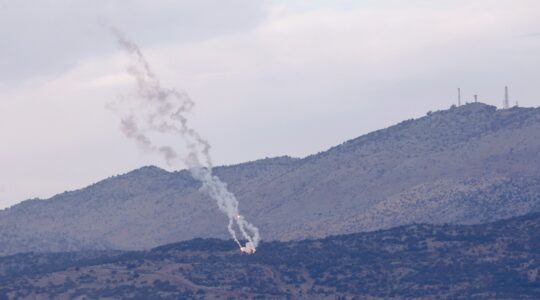
At left, Paula Goldberg, left, and Judy Viteli, pictured with their father at the kochelein. (Courtesy of Paula Goldberg) The sisters today; Viteli is at left. (Uriel Heilman)
The later years
By the 1960s, things had begun changing at the kochelein. A pool had been built. Two more bathrooms were added to the main house. There had been three or four bungalows onsite at least since the early ’50s, but in the ’60s the owners decided to build several more, enlisting the summertime kids to help.
Most significantly, the owners cut a deal that traded the use of part of their land to Kutsher’s in exchange for nightly passes to the resort’s shows. Kutsher’s eventually bought the bungalow colony outright.
“That changed our lives,” Paula recalled. “Our parents could get dressed up and go every night and see all the Borscht Belt comedians. They could go dancing on the stage. Our little bungalow colony had very special power based on the land.”
Judy says she enjoyed the shows, except for one thing: “The comedians would tell their joke, and then the punchline would be in Yiddish. I’d ask Mom what he said and she’d say, ‘I’ll tell you later.’ ”
When she was old enough, Judy began working summers at Kutsher’s as a camp counselor. It was hard work, she says: 12-hour days, six days a week, for just $15 per week. At the kochelein, the traditions continued.
At summer’s end, when each family finished packing up the car to leave, the remaining families would assemble for a parting ceremony. They’d all bang pots and pans and sing a song to the tune of the “The Farmer in the Dell”:
We hate to see you go
We hate to see you go
We hope to heck you never come back
We hate to see you go
The Goldbergs were usually the last to leave.
“We left a day later than everyone else because God forbid we should get stuck in traffic,” Paula recalled.
As they graduated high school and college, the number of kids at the bungalow colony dwindled. Some went up only for weekends, some not at all.
Even as the Catskills fell into decline in the ’70s and ’80s, the adults kept going to the Fairhill kochelein — relishing the space without kids, according to Paula. They stopped only when they couldn’t physically do it, obstructed by illness, death or retirement to Florida.
By the 1990s, most of the kochelein’s rooms were empty.

The Goldbergs’ bedroom at the kochelein looks pretty much the way it did the last time they left it, in August 2002. (Uriel Heilman)
But not the Goldbergs’; they were diehards. Even when Nat and Sylvia took a place in Florida for the winter, they would return to Monticello for the summers. Sylvia kept three separate bottles of moisturizer so she could travel lighter: at her bedside at the kochelein, in Florida and in Yonkers, where the couple moved when they left the Bronx. (Snooping around the abandoned property, I spotted Sylvia’s bottle of moisturizer.)
With the surrounding area growing shabbier every year, the Goldberg kids tried to convince their parents to stop going to the kochelein — or at least get a room for the summer at Kutsher’s, which by now they could afford. But Nat and Sylvia wouldn’t budge.
“To me it was depressing to go up in those later years,” Judy said. “My mother’s sister used to bring up all her money for the summer and hide it in her room. When she had a stroke in the middle of one summer, her son asked us to find the money and we couldn’t. Eventually someone found it.”
The last few summers the Goldbergs spent at the bungalow colony, they were the only couple there.
“It was eerie,” Judy said. “You would go upstairs and all the other rooms were abandoned looking.” Nat and Sylvia would spend their days at Kutsher’s — Sylvia in pottery classes making tchotchkes that she’d take back to the kochelein and hang on the walls, Nat outside organizing shuffleboard games. At the end of the day they would go back to their big, empty house at the bungalow colony to eat and sleep. Though there were half a dozen refrigerators, they still confined themselves to the same half-fridge they always used.
“It felt like the ‘Twilight Zone’ to me,” Paula said. “Dad was 92. We were scared already. They were living alone in that big house and crossing over to the dining room for meals. They were anachronisms.”
Finally, in the summer of 2002, after 50 years of summers at Fairhill, the Goldberg kids managed to convince their parents to forego the kochelein for the following summer, and they booked rooms at Kutsher’s for 10 weeks starting in June 2003.
But when Nat and Sylvia left the kochelein at the end of August 2002, Sylvia was complaining about feeling tired, and she spent that fall in and out of doctor’s offices. She was diagnosed with cancer.
“After we booked them into 10 weeks at Kutsher’s, my mother felt like a very rich lady,” Paula said. “Even when she was in hospice, she thought she’d spend the summer at the hotel.”
Sylvia never made it. She died in July 2003.
Nat, 10 years her senior, held on for nearly another decade, living until the age of 100. He died in June 2010.
Today, the Jewish Catskills is largely a relic. There are still a few bungalow colonies scattered about, and some haredi Orthodox camps have put down stakes, but all the great Jewish hotels have been sold off or abandoned to nature and decay.
Kutsher’s, the last holdout, was sold in late 2013 for $8.2 million to Veria Lifestyle Inc., a company owned by Indian billionaire Subhash Chandra. He plans to build a new health and wellness resort at the site.
Decades on, the kochelein still maintains a hold on the Goldberg sisters — and many of the others who spent their childhood summers there. In 1996, when the sisters held a 50th anniversary party for their parents at Paula’s Westchester home, many of the old kochelein kids showed up for the occasion.
“They were like family,” Paula says.
At Paula’s insistence, she and Mark used to drive to Monticello every year on Aug. 2, the anniversary of their first date. Then last year, for the first time, Paula decided she didn’t want to go anymore. It was just too sad and spooky.
From what I saw on my foray there, it’s also dangerous. There’s no telling when a floor might collapse or the roof cave in. The property is a wreck.
But it’s also full of artifacts — enough for an enterprising visitor to decode the mystery of the copious fridges, the half-full bottle of moisturizer, the piano in the corner of the dining room. Enough, that is, to tell the Goldbergs’ story.
Fairhill, Then and Now: A Slideshow:





